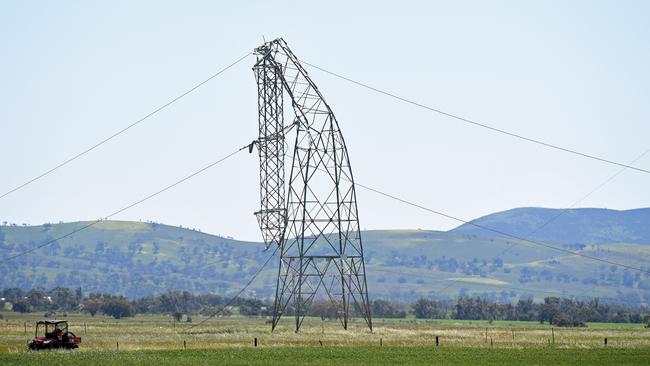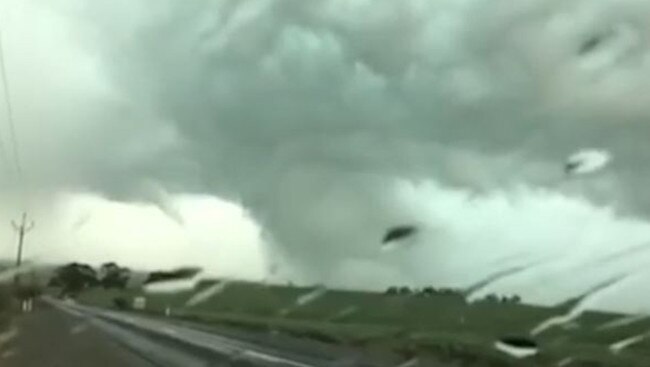Seven tornadoes hit SA on day of massive blackout: Bureau of Meteorology report
SEVEN tornadoes, some reaching speeds comparable to Hurricane Katrina, ripped through SA on the day of the statewide blackout in September, the Bureau of Meteorology has confirmed.
SA News
Don't miss out on the headlines from SA News. Followed categories will be added to My News.
- Why the wind farms failed in the superstorm
- ‘Multiple faults’ led to huge SA blackout, preliminary report says
- Public sides with Weatherill on blackout explanation
- Analysis: Why weren’t we better prepared
SEVEN tornadoes, some reaching speeds comparable to Hurricane Katrina, ripped through SA on the day of the statewide blackout in September, the Bureau of Meteorology has confirmed.
The Bureau has released its report into the first day of September’s superstorm, which caused an unprecedented power outage across SA and caused tens of millions of dollars in damage throughout the state.
The organisation has mapped out the paths and determined the wind speeds of the tornadoes, which broke out on Wednesday, September 28.
It was previously believed two tornadoes smashed the Mid North area and another smaller tornado hit McLaren Vale but the new report revealed seven lashed the state.
The bureau’s report showed wind speeds during a tornado that started at Wilmington reached up to 269km/h — 11km/h less than the highest wind speeds recorded during Hurricane Katrina, which killed more than 1200 people when it slammed the United States in 2005.
The 20-minute tornado, which overturned a caravan and caused the collapse of metal truss transmission line towers and a shed, travelled 30kms, ending about 6kms north of Booloroo Centre.

The document also showed a tornado that began near Blyth at about 3.35pm and travelled 19kms southeast before ending 15 minutes later at Kybunga, reached wind speeds of up to 266km/h.
It also toppled metal truss transmission line towers, blew the roofs of houses and a church hall and threw a timber beam more than 200m into a shed wall.
A third tornado that started near Survey Rd at Wild Dog Creek ripped a 23km-long trail of destruction to Appila Rd, 10kms south of Booloroo Centre.
This 25-minute tornado, with wind speeds of up to 259km/h, picked up large field bins, weighing more than one tonne, and hurled them 300m in the air.
Meanwhile, in the Clare Valley, a tornado carved a 4km track from about 5kms south of Mintaro to near Brothers Hill Rd.
The report described the storm as “one of the most significant severe thunderstorm outbreaks in recent decades”.
“Multiple supercell thunderstorms produced damaging to destructive wind gusts, including at least seven tornadoes, very large hailstones and locally intense rainfall,” it read.
“These supercell thunderstorms and tornadoes impacted the South Australia power network, contributing to a statewide power outage.”

The Climate Council used the storm as an example of the extreme events to come in the release of their latest report, Super-charged Storms in Australia: the Influence of Climate Change.
“This storm formed in an atmosphere that is packing more energy and is holding more moisture a result of climate change,” the authors stated.
“The storms in South Australia highlight the threat posed to critical infrastructure from more destructive extreme weather driven by climate change. The resilience of all our major
infrastructure and essential services needs to be designed for the increasing intensity and severity
of the extreme weather that we are experiencing as a result of climate change.”
Energy Minister Tom Koutsantonis said the report confirmed that two of the tornadoes “destroyed the spine of our transmission network, triggering the statewide blackout”.
“The voltage shocks sustained as a result of that destruction caused a cascading event that sent the state black,” he said.
“This report should put to rest the debate over who or what was to blame for the blackout.
“Prime Minister Malcolm Turnbull and Deputy Prime Minister Barnaby Joyce have both used the blackout to attack renewable energy policies in other states.
“And as recently as just a few weeks ago Steven Marshall claimed in parliament that storms did not caused the blackout, and accused the Premier of misleading parliament when he suggested they did.
“It’s time opponents of renewable energy accept that fact.”
However Opposition energy spokesman Dan van Holst Pellekaan dismissed Mr Koutsantonis’ assertion that the report showed the thunderstorm was responsible for the blackout.
“Contrary to Minister Koutsantnonis’ desperate spin the BOM report merely confirms what
was already well known – that the storm brought down transmission lines the north of the
South Australia,” he said.
“The BOM report in no way explains why storms pulling down transmission lines in the north
of the state plunged the whole of South Australia into darkness.”
Mr van Holst Pellekaan said the bureau was not charged or qualified to investigate the cause of the statewide blackout.
“Australian Energy Market Operator will need to determine why the collapse of transmission towers in the north of the state resulted in the south of the state losing power despite no damage to the gas generators in Adelaide or the transmission lines supplying energy from those generators to Adelaide and all regions south,” he said.
“I’ll wait for the final AEMO report but I note that the wind farms were the first generators to
go down, the interconnector was next and the gas generators were the last.”



